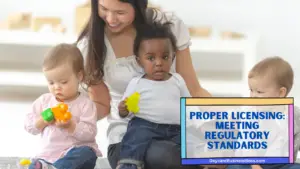Choosing the best daycare for your child is an extremely important decision. A well-structured daycare checklist is your compass in this attempt, whether you’re a working parent looking for dependable care or a passionate educator looking to establish an amazing environment. A daycare checklist serves as a blueprint, ensuring that all necessary parts are in place to provide a safe, stimulating, and caring environment for children.
To create the best daycare checklist, you should prioritize safety measures, qualified staff, age-appropriate activities, a clean environment, a low child-to-staff ratio, positive reviews, proper licensing, health protocols, and open communication with parents.
In this article, we will look at the essential elements that should be considered while creating a childcare checklist. Join us as we investigate the essential factors that must be carefully considered in your quest to discover or improve the ideal daycare facility.
Safety Measures: The Foundation of Trust

In any daycare facility, safety takes precedence over all else. A comprehensive childcare checklist must begin with an emphasis on strong safety precautions. The core of this checklist is the requirement that the facility be meticulously childproofed. This includes a variety of items such as windows with secure locks, strategically placed safety gates to prevent unintentional wandering, and electrical outlet covers that act as protective barriers.
Being prepared for unforeseen scenarios is vital; hence, a well-structured fire and emergency evacuation strategy is not only required but also must be performed regularly to instill seamless execution during critical moments. First aid materials, which are essential in dealing with minor injuries, should be easily available on the premises. The skill of staff members in key life-saving methods such as CPR and basic first aid is an integral aspect of the safety checklist, in addition to their mere presence.
The assurance of parents’ peace of mind is closely related to the rigorous monitoring of those working in the childcare environment. Background checks, which are an absolute must, add an extra layer of protection by weeding out any potential hazards associated with personnel or volunteers. In essence, safety is the core of the daycare checklist, meticulously woven into every aspect to create an atmosphere in which children thrive under constant supervision.
Read more about: Bright Futures, Safe Present: The Daycare Environment Safety Checklist
Qualified Staff: Nurturing Minds and Hearts
Every daycare’s growth is built on its dedicated employees, who have an unrivaled influence on the quality of care and education delivered. Creating a rigorous daycare checklist necessitates a strong emphasis on the hiring of skilled and experienced personnel. The instructors chosen to nurture and educate young minds should have a diverse set of qualifications, including early childhood education certification. These qualifications attest to their skill and dedication to promoting a healthy developmental environment.
Qualifications alone, however, are insufficient; the art of engaging, teaching, and nurturing children in a way that fosters growth and confidence is essential. The checklist broadens its scope to include this critical characteristic, recognizing that staff’s capacity to connect with children on a deep level shapes their learning experiences and emotional development.
Stagnation is the enemy of growth, particularly in the fast-paced world of childcare and education. As a result, the checklist includes an additional requirement: regular training. Continuous education in areas such as child development, communication tactics, and behavior management broadens staff expertise and provides them with the tools they need to respond to changing demands. This aspect guarantees that employees are up-to-date and effective in their roles.
Age-Appropriate Activities: Fostering Growth and Learning
Children’s development is tightly linked to their participation in activities that flawlessly sync with their increasing developmental milestones. The daycare checklist is unequivocal in its emphasis on the inclusion of age-appropriate activities, understanding that this serves as a critical basis for a supportive learning environment.
The curriculum design is central to this approach, in which a mosaic of intellectual, artistic, and physical activities combine to respond to the unique demands and interests of each age cohort. The checklist emphasizes the significance of properly designed encounters that spark young minds. The range broadens to include outdoor exploits that fuel their physical prowess and sensory exploration that unfurls a universe of textures, scents, and sights, in addition to narrative sessions that ignite their imagination and art and crafts initiatives that channel their creativity.
The basic principle of the checklist is holistic growth and development. It recognizes that a symphony of varied activities not only broadens a child’s knowledge but also fosters emotional intelligence, social savvy, and physical agility. Children that dabble in these diverse areas develop a well-rounded set of talents as well as a sophisticated grasp of the world around them.
Clean Environment: A Healthy Haven

When it comes to protecting the health and overall well-being of young children, the importance of a clean and sanitary environment cannot be stressed. The childcare checklist is adamant about establishing precise cleaning routines and stringent disinfection measures. This foundation is based on the concept that a clean environment is critical in preventing the spread of germs and diseases.
Toys, surfaces, and common areas are focus points in this attempt, requiring frequent and thorough cleaning to remove any hiding hazards. The checklist’s mandate includes not just the consistency of these cleaning processes, but also the use of complete disinfection practices. Such precautions are not only preventative but also proactive, acting as barriers to the beginning and spread of infections.
Along with these steps, the checklist emphasizes the importance of correct waste disposal techniques and meticulous diaper-changing processes. These seemingly little details are part of a wider hygiene mosaic that contributes to the overall health and safety of the childcare setting.
Read more about: Creating a Nurturing Environment: The Essentials of Running a Thriving Daycare
Low Child-to-Staff Ratio: Individualized Attention
The key to a good childcare setting is to keep the child-to-staff ratio as low as possible. This instruction, which is included in the daycare checklist, emphasizes the critical need for tailored attention and constant observation. The checklist is categorical in its instruction, with a clearly stated maximum number of youngsters that a staff person can responsibly supervise.
This approach recognizes that a lower child-to-staff ratio is an investment in each child’s emotional and cognitive development. In effect, it opens the door to a slew of benefits. With fewer children under the care of a caregiver, the opportunity for specialized attention increases. This focused engagement enables caregivers to closely notice each child’s distinct characteristics, preferences, and developmental milestones, building a stronger bond between caregivers and the children in their care.
This strategy has far-reaching consequences. Personalized counseling improves educational outcomes by focusing on unique needs and talents. Children’s emotional development flourishes when they form strong relationships with caregivers, boosted by the awareness that their concerns are heard and their feelings validated. Overall happiness abounds within this caring cocoon, as youngsters thrive in an atmosphere that values their uniqueness and promotes their development.
Positive Reviews: Insights from Others
Positive reviews and testimonies serve as a light of important insight when it comes to choosing the best daycare for your child. The childcare checklist recognizes this and broadens its scope to include the painstaking effort of investigating and compiling feedback from many sources. This creates a crucial compass for navigating the maze of a daycare’s quality, reputation, and track record.
The checklist emphasizes the significance of casting a wide net and pulling from a variety of sources to acquire thorough knowledge. It encourages you to investigate both the virtual and the domain of word-of-mouth recommendations. Online platforms are a goldmine of first-hand reports, shedding information on parents’ interactions with the daycare in question. These narratives, which range from the personal to the pragmatic, act as guiding lights on your decision-making path.
However, the checklist is not limited to the digital realm. It respects the credibility of word-of-mouth recommendations, which frequently carry an unfiltered and genuine sentiment. Parents who have committed their children to the daycare provide invaluable anecdotes that offer a clear picture of the facility’s strengths and opportunities for improvement.
Proper Licensing: Meeting Regulatory Standards

An unbroken emphasis on the irrefutable importance of a facility’s license and rigorous adherence to local standards is embedded throughout the key concepts of the childcare checklist. This aspect is an unequivocal requirement, mirroring the checklist’s unwavering commitment to assuring the childcare haven’s ultimate safety, well-being, and operational integrity.
The checklist emphasizes the importance of careful verification, which serves as a litmus test for a daycare’s dedication to sustaining the highest standards. Licensing validates a facility’s unwavering commitment to achieving and exceeding the stringent safety, health, and operational norms established by the relevant authorities. This mark of approval assures parents that their children are in a safe environment that promotes their care and development.
Aside from its administrative importance, licensing serves as a symbolic marker of accountability. It demonstrates a facility’s unshakable commitment to providing a safe, supportive, and suitable environment for children to thrive. Licensing confirms that the facility is a partner in the efforts of parents, echoing their hopes for their child’s overall development.
Read more about: Building Trust in Daycare Selection: The Ultimate Evaluation Checklist
Health Protocols: Prioritizing Wellness
Health protocols have risen to unprecedented prominence in the contemporary scene. The daycare checklist, acutely aware of this paradigm shift, broadens its embrace to include a full variety of measures aimed to stop the spread of infections. This multifaceted strategy serves as a fortress against the vulnerabilities of contagion and disease, putting children’s and staff’s well-being first.
The checklist cleverly includes the creation of rigorous regulations for disease reporting, exposing a path that promotes transparency and early response. A solid structure for monitoring health-related concerns enables the daycare to respond quickly to possible hazards, reducing the danger of epidemics and protecting the community’s collective health.
Immunization requirements are another important pillar of this health-oriented structure. The checklist specifies that up-to-date vaccines are required, to protect the daycare from preventable infections and boost herd immunity. It also emphasizes the importance of frequent health check-ups, when children and workers are closely watched. This proactive approach not only identifies potential health issues but also emphasizes the daycare’s dedication to the overall well-being of those involved.
The adoption of the checklist extends beyond policy to include the physical sphere as well. Adequate ventilation and strong hygiene standards combine to create a health-conscious and flourishing atmosphere. This synergy guarantees that the air we breathe is clean and fresh and that surfaces and hands are cleaned regularly, minimizing the risk of pathogens taking root.
Open Communication with Parents: Building Trust
The daycare checklist provides a clear path to an important nexus: the symbiotic collaboration between daycare providers and parents, which is inextricably knit into the fabric of a child’s well-being. This partnership, resolutely supported by the checklist, serves as an essential cornerstone, sustaining an ecology in which children grow holistically.
An unwavering emphasis on open avenues of communication is ingrained in this mentality. The checklist emphasizes that consistency in updates, progress reports, and opportunities for parent-teacher meetings provides the foundation for trust and collaboration. This dynamic interchange builds a bridge of knowledge across the two worlds that influence a child’s development.
In essence, the checklist serves as a guide for providers, directing them to create an environment in which parents are active participants in their child’s journey rather than passive onlookers. Timely updates and insightful progress reports provide parents with a bird’s-eye perspective of their child’s daily activities, allowing them to seamlessly sync their involvement with the child’s development.
The checklist enables providers to plan a variety of opportunities for parent-teacher conferences. This staged engagement provides a forum for exchanging ideas, addressing problems, and co-creating solutions to support the child’s development. This place supports the partnership, changing it into a dynamic cooperation in which expertise from both sides converges, boosting the child’s developmental potential.
Frequently Asked Questions

What is the significance of a childcare checklist?
A daycare checklist is necessary because it guarantees that all important parts of childcare are covered, resulting in a safe and caring environment for children. It assists parents, guardians, and educators in focusing on critical areas such as safety measures, staff credentials, activities, hygiene, and communication, ultimately contributing to the growth and well-being of children.
How can I assure my child’s safety in a daycare facility?
Check for childproofing, secure windows, and emergency plans as a top priority. Ensure that all employees are thoroughly background checked, have CPR and first aid training, and work in a hygienic atmosphere. A low child-to-staff ratio also ensures customized attention, establishing a safe environment.
How important is open communication with parents in daycare?
Open communication between caregivers and parents fosters trust and teamwork. Parents are kept updated about their child’s experiences and development through regular updates, progress reports, and meetings. This involvement allows parents to actively contribute to their child’s development while also assisting childcare providers in tailoring their approach to each child’s specific needs.
To learn more on how to start your own daycare checkout my startup documents here.
The information provided by DaycareBusinessBoss.com (“The Site”) is for general informational purposes only. All information on the Site is provided in good faith, however, we make no representation or warranty of any kind, express or implied, regarding the accuracy, adequacy, validity, reliability, availability or completeness of any information on the Site. Under no circumstance shall we have any liability to you for any loss or damage of any kind incurred as a result of the use of the Site or Reliance on any information provided on the Site. Your use of the Site and your reliance on any information on the Site is solely at your own risk.
This blog post is for educational purposes only and does not constitute legal advice. Please consult a legal expert to address your specific needs. Terms and Conditions. (https://daycarebusinessboss.com/terms-conditions/)

Meet Shawn Chun: Entrepreneur and Childcare Business Fan.
I’m a happy individual who happens to be an entrepreneur. I have owned several types of businesses in my life from a coffee shop to an import and export business to an online review business plus a few more and now I create online daycare business resources for those interested in starting new ventures. It’s demanding work but I love it. I do it for those passionate about their business and their goals. That’s why when I meet a childcare business owner, I see myself. I know how hard the struggle is to retain clients, find good employees and keep the business growing all while trying to stay competitive.
That’s why I created Daycare Business Boss: I want to help childcare business owners like you build a thriving business that brings you endless joy and supports your ideal lifestyle.


